Let’s Talk Graffiti and Sustainable Development
Video games have become so immersive in the ways we can interact with non-playable characters and the fictional worlds that they live in. We have always imagined what it would be like to stand alongside our characters and carry out their quests with them. It also has influenced us to imagine living a life and doing every day activities from the comfort of our homes. These ideas have contributed to the development of virtual and augmented reality. Using our phones and/or special virtual reality headsets, we have been able to transform the space around is and create simulations of products and worlds that we can interact with from our own points of view. Many people are familiar with virtual reality games such as Beat Saber (2018) and Superhot (2016) where the space is altered around us and objects are flying towards us. Average people are even capable of making their own virtual reality spaces to share with people and we can meet people online in our own avatars. Using virtual reality, we can now make our online connects even more personal. It is even used for educational purposes like viewing simulations and models of space, the human body, and walkthroughs of museums. But how else can virtual and augmented reality be used to make an every larger impact on the outside world and people we meet? Well I believe that is possible with Kingspray Graffiti VR (2019), a virtual reality game that allows you to spray paint graffiti at several different locations. You may be asking, how can a simulated illegal activity help to spread any sort of positive world messages? First, let’s hear from graffiti artist Gabe Gault.
Gabe Gault was asked by the creators of Kingspray Graffiti VR and to walk us through his process on how he creates work using spray paint. He typically is commissioned to create large wall murals, but in this video he is showing that same process in this virtual landscape and explain his artistic and creative decisions. His final result was meant to be his interpretation of the future of exploration, depicting a woman of color as an astronaut. In this short 3 minute video, he is able to convey such a simple and meaningful message through graffiti. While graffiti does have a negative connotation, it is important to understand how graffiti has not only transcended into a valid and sought after art form and style, but has also been around for centuries.
Why Does Graffiti Matter?
Graffiti is loosely defined as the vandalism of public property, typically using paint or other mediums that alter the surface in an artistic or creative way. The content itself does not necessarily need to be “offensive” or “gang-affiliated” or have that specific organic style to be considered graffiti. The difference between graffiti and a mural is that the artist is given permission to create the mural. But then why do we still refer to it as graffiti if it is legal? Its because graffiti, historically, has always been so much more than just vandalism and because of its long history, “Graffiti” has developed into a style of art and an art form itself. The earliest known graffiti is cave paintings. Depictions of hunts and prehistoric animals on what would be considered public cave walls. From back then to the present, graffiti has always been used as forms of record keeping, decorating, rebellion, and propaganda. Graffiti has contributed to much of what we know about those who came before us. Graffiti has always been a sign of civilization, its good and its bad parts. And that has not changed. Overtime, urban areas developed a bubble lettered, organic style of graffiti that was often associated with gangs and violence. But tags and messages placed by those in modern cities serve no different purpose than those of our ancient ancestors. But because the style has changed to something so much more bold and bigger than older graffiti, people began to take even more offence and to stand against it. That is not to say we should be supporting messages of violence, but the purpose of graffiti has always been to share a message. And if people are not listening, then graffiti artists will make their messages so you cannot ignore them. And because of this constant pushing by graffiti artists to be seen and by others for them to stop, that is how we have developed graffiti into this very vibrant art style that is so sought after. Graffiti has always been done to convey a message, now we just know how to do so more clearly with citizens and corporations having taken part in this process.
(Please view the TEDEd link to learn more about the history of graffiti and its historical and cultural significance.)
Sustainable Development Goals Graffiti Projects
SDG Street Art (2020)
As mentioned, graffiti (also known as street art) has always been done with the purpose of conveying some sort of message and it has developed into an art form used by many large organizations. The United Nations’ Sustainable Development Goals have been the influence of two graffiti based projects. SDG Street Art was an event held in Cork City, Ireland where participants were able to spray paint images and messages related to the 17 SDG’s on a public wall (with permission of the city to do so.) The purpose was to spread information about what the SDG’s are and gain more attention for the global project.
Mongolia Graffiti Art Campaign (2017)
Another graffiti project was a campaign done in Mongolia by a single young artist, sponsored by the Global Goals Organization. This artist painted his interpretation of each of the 17 goals on the walls outside of Mongolia’s United Nations House. Again, the purpose was to share these global goals with their community and gain more attention to all of the goals and causes being targeted by the United Nations.
How Students Can Use Graffiti to Spread a Message
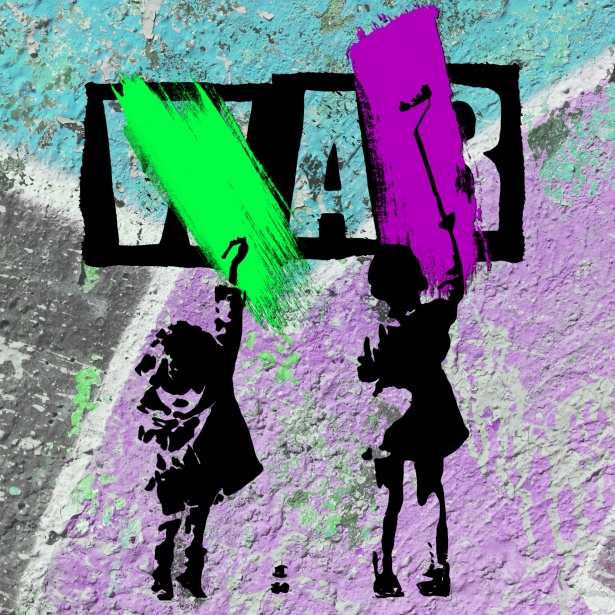
These next ideas can be done by anyone of all ages, but I came up with these ideas coming from the mindset of an aspiring art teacher. Because graffiti in many cases is illegal and it takes special permissions to be able to create public murals which are very difficult to get, I want to consider Kingspray VR as an alternative and a foundation for something greater. Let’s say students were to pick an SDG and target they felt strongly about or another cause and they used the app, individually or collaborative, to create virtual graffiti murals that represent and promote their chosen cause. It is a fun and unique way for students to create meaningful work while also incorporating new technology into the classroom. If we wanted to expand their projects and share them, while again it would be difficult to get a sponsor to want to have students work blown up and plastered on public walls, it can be blown up and plastered in schools. Imagine a graffiti art show where all of the art they created in virtual reality was downloaded and displayed all around a school gym or auditorium. Or if they were used to cover walls or bulletin boards around the school. Or if you wanted to use even more technology, you could consider developing it into an augmented reality art show where their graffiti pieces are turned into AR model that can be scanned on devices and viewed in the real world on a blank wall through a smartphone or tablet. And I understand that for many schools it would be difficult to give many students the opportunity to create full pieces of work in virtual reality, but it can even be altered to them practicing in virtual reality and creating sketches and then painting them on large pieces of news print of bulletin board paper.
I think virtual and augmented reality, more specific Kingspray VR, as well as graffiti can be used to spread very powerful messages and can be developed into unique expansive projects for anyone. I do believe it is worth considering and checking out for yourself.
DOWNLOAD KINGSPRAY GRAFFITI ON OCULUS QUEST TO SHARE YOUR OWN MESSAGE!
Thank you for reading!
Follow me on Twitter at @IreneOrtiz001
Virtual and Augmented Reality
How can you use VR and AR in the classroom? Virtual Reality engages multiple senses, sight, touch, hearing, and sometimes smell! In the classroom, you are not just observing material but actually being part of it. You can explore the world and visit different locations. There are virtual field trips that you could take your students on to let them explore different areas, you could check out interactive simulators to see how earthquakes affect the land and structures around them. Another example of using virtual reality in the classroom is learning about the anatomy of humans, their organs, and bones and dissecting animals as well. All of these tools give students a greater understanding and a closer look at how things work.

Augmented Reality is digitizing classroom learning. It takes what you have and enhances it. For example, it can take your drawing and make it come to life. It doesn’t require any new materials. It can be accessed with your own computer and materials.

Now that we know a little about them how can vr and ar contribute to possible successful global collaborations or meet a global goal? When I think about global goals I know that they are big goals but with lots of people all working together collaboratively they can be met. With the use of vr and ar tools we can get even more people involved and aware of what the global goals are. What are the steps to get there? With the help of the Oculus you can download an experience called Pollinator Park. This would relate to SDG 2: Zero Hunger. Pollinator Park shows what our world would look like without pollinators. According to the United States Department of Agriculture, “Pollinators help ensure the world eats. Scientists estimate that about 75% of the world’s flowering plants and about 35% of the world’s food crops depend on animal pollinators to produce. While more than 3,500 species of native bees help increase crop yields, pollinators include many more species than just bees. Flowers can be pollinated by both insects and animals – such as bees, wasps, moths, flies, butterflies, birds and even small mammals such as bats. Despite their importance, many pollinators are declining in numbers, posing a threat not only to the world’s ecosystems but to global food security as well.” Showing how this is important can help students want to be involved at home and in school.
Check out this video of Pollinator Park in action!

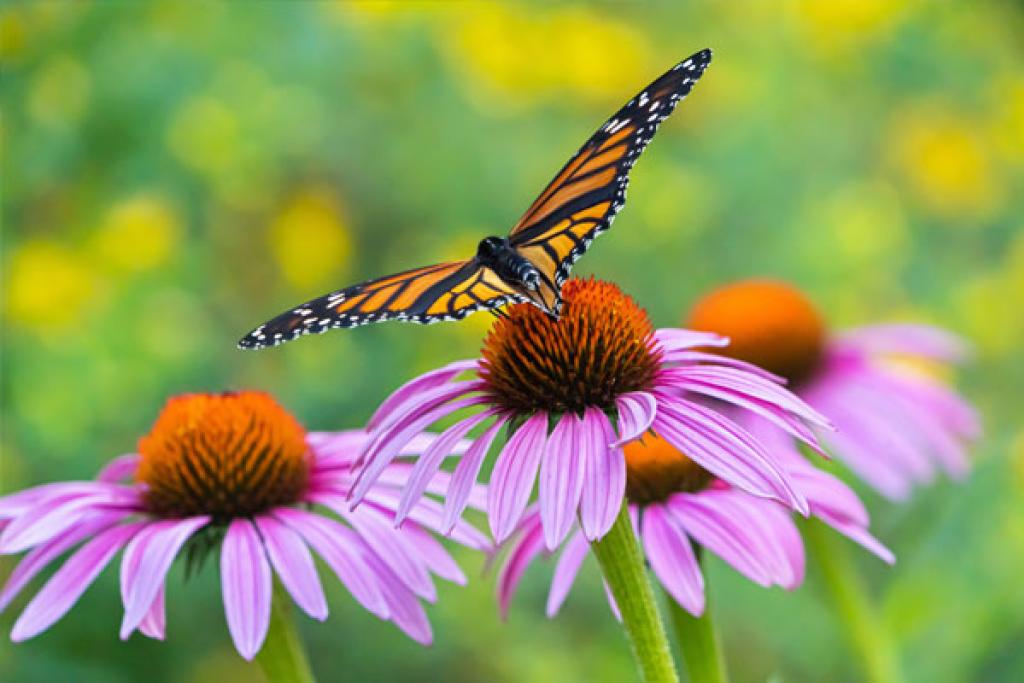
Experiences like Pollinator Park are numerous. There are ones that focus on other sustainable global goals as well. I looked for the ones that focused on SDG 2 as that was what I focused on this semester. Another VR experience that stood out to me was Cooking Simulator. Unlike Pollinator Park, this experience is not free. What I did like about this is that it helps you learn how to cook the food that you are growing, teaching the basic cooking mechanics like slicing and learning cooking temperatures which are lifelong skills to have.
As a future educator learning about VR and AR, I’m excited to see how I can use this in my future classroom. In my local school, we don’t have VR tools for students or the budget for them but to get that would be amazing. Hearing that the AR features don’t cost extra and use what you have is exciting and I want to see how I can incorporate that.
Virtual & Augmented Reality
Virtual Reality (VR) in classrooms can reform education and contribute fundamentally to successful global collaborations, especially in accomplishing the United Nations’ Sustainable Development Goals (SDGs). For this discussion, we should zero in on utilizing Google Earth Visits in K-12 education to address the Global Goals I’ve accomplished for my project, Global Goal 4: Quality Education.
Global Goals 4 expects to guarantee comprehensive and impartial quality education and advance deep-rooted learning open doors for all. VR devices like Google Earth Visits can assume a significant part in gathering this goal by giving vivid and intuitive growth opportunities that rise above customary study hall limits.
Google Earth Visits

Google Earth Visits is an instructive apparatus that permits instructors and students to investigate the world practically through 360-degree all-encompassing pictures. It will empower students to “travel” to different areas and experience virtual field trips. By utilizing VR headsets, for example, Google Cardboard or the Oculus Mission 2, students can feel present in those areas, regardless of whether they are many miles away.
Within this video provided by Google, we are able to look into the way Google Earth working with VR shapes our experience.
Upgraded Global Collaborations
VR can break social obstructions and cultivate multifaceted comprehension. By encountering better places, societies, and networks through VR, students can foster sympathy and appreciation for variety, prompting more agreeable Global coordinated efforts. VR can also work with constant cooperative tasks among students worldwide. For instance, students from various nations can collaborate on a virtual recreation of verifiable destinations or work together to tackle worldwide difficulties like environmental change or ecological preservation. Next, VR can establish language learning conditions where students can work on talking and listening abilities with local speakers from various nations, advancing language capability and intercultural correspondence. And finally, Through VR encounters, students can acquire a more extensive point of view on worldwide issues like poverty, inequality, and environmental degradation. This understanding can motivate them to become proactive worldwide residents and work together to address these difficulties.
Meeting Global Goal 4 – Quality Education
VR innovation permits students in underserved regions or far-off areas to get instructive encounters they probably won’t have. Virtual field excursions to galleries, verifiable destinations, and regular marvels can enhance their learning and advance a more comprehensive school system. Also, VR gives a seriously captivating and intelligent learning climate, which can improve students’ maintenance and comprehension of perplexing themes. It can make learning fun, starting interest and adoration for learning. VR can take special care of assorted learning styles, furnishing customized opportunities for growth to students with various capacities and learning inclinations. This inclusivity lines up with the rule of abandoning nobody, as underlined in the SDGs. And finally, VR can likewise be utilized for proficient improvement for instructors, empowering them to encounter new showing techniques, best practices and team up with teachers worldwide. This constant learning can work on the nature of schooling conveyed in homeroom.
Within a lesson plan employing Google Earth’s wonders, we have been given the following instructions…
“Teachers can use I’m Feeling Lucky and Street View in Google Earth to randomly select a location in the world and relate it to multiple content areas. Teachers can also choose to preselect a location that lends itself well to relevant standards and objectives using Search or Voyager Stories.”
https://storage.googleapis.com/gweb-earth/education/pdf/EN_PassportWarmUp_7thGrade.pdf
This captivating lesson, accompanied by its counterparts found within the provided link, seamlessly integrates the power of VR and Google Earth, culminating in a plethora of thrilling educational experiences for young minds.

Utilizing Google Earth Visits or comparative VR apparatuses in homerooms can add to practical worldwide joint efforts and accomplish Worldwide Global 4: Quality education. By cultivating compassion, breaking social boundaries, and giving admittance to different learning potentials open doors, VR can engage students to become dynamic members intending to worldwide difficulties and pursue a manageable future.
Ocean Adventures With VR
Traveling the world can be added into a lot of global goals to improve the learning experience; with the assistance of VR traversing the world becomes easy. Exposure to more parts of the world can dramatically help with education towards SDG 14, Life Below Water. VR and its ability to connect with and tour areas of the world without having to go there physically allows for a more interactive and immersive learning experience.
Thanks to computers and advancements in technology we are able to connect with people through applications like Skype and through this we can talk with experts from around the world and connect with different communities. The ability to connect to others also allows for a greater number of people working towards one goal.
There are resources for educating those on Global Goals and they provide a lot of good information in the forms of videos, PDFs, and classroom activities, however, I think that VR can greatly improve the learning experience of SDG 14 by putting people in the underwater world. By giving this experience we can see different species of marine life, ranging from animals to plants, and go on to learn about their importance. VR gives a more personal experience to learning in my opinion. Instead of students recalling that they looked at a fish, or cephalopod, or the coral reef, in a textbook, they can instead recall the time they were transported to the ocean and got to witness how these organisms lived.

Youtube 360 Videos are a great way to implement learning about SDG 14 with VR. These videos allow the viewer to take control of what they are looking at. It is an incredible experience to spin around in the depths of the ocean. Thanks to the videographers and cameras used to capture the footage it feels like you are actually down in the waters exploring by yourself. A video I liked was, 360° Underwater National Park by National Geographic; this video explores the ocean, showing the coral and sea turtles around Buck Island, the first American protected marine monument.

Journey Into the Deep Sea – VR, is another video from national geographic that allows for 360° control as you learn about the Coral Reef and its importance to the ocean ecosystem. The video talks about the Coral Bleeching that happened in 2016 and emphasizes how important the Reef is and how protecting the ocean is a global movement.
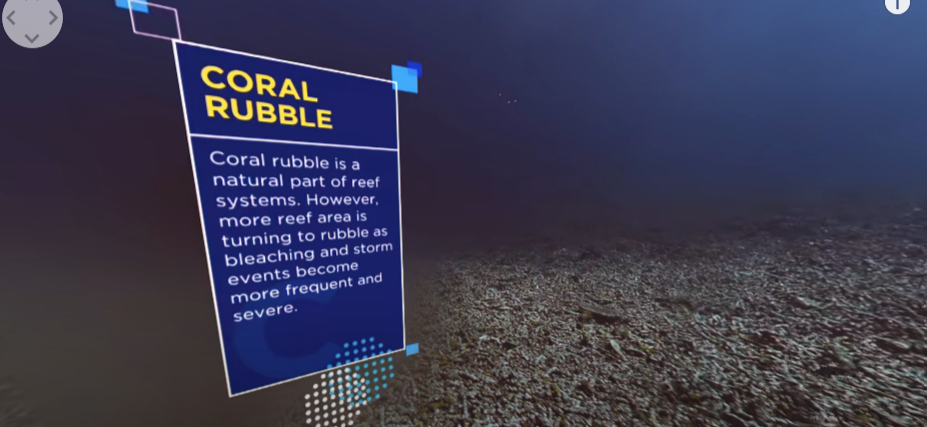
Another Video that I liked was Swimming with Giants 360. This video from, the American Museum of Natural History, put you in the middle of the ocean and has a variety of animal swim by as you look around and follow where they go.
360° Sea Plastic is a video from, the Jetlagged – Ocean Films and Adventures, about ocean pollution. In it they talked about the fragile ocean ecosystem and how it was created to be perfectly balanced. Now the production of plastic has increased, causing an equal increase in plastic waste, that unfortunately, ends up in our water and that puts the ecosystem in danger. This video shines a light on the grim reality of the plastic problem and how we need to band together in order to make a difference. I think this video is great for showing a real problem the oceans and water ways face by putting the viewer in areas where the improper disposal of plastic waste is negatively impacting some communities.
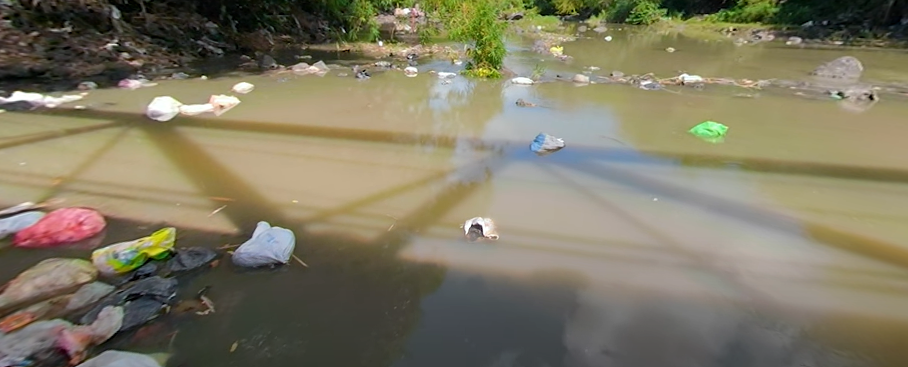
I found the National Marine Sanctuaries website while looking into VR technology and how it can be applied to teach about Ocean life. When you get to the website your able to select Education under the Learn tab. This leads to even more choices and gives resources to teachers and students. One in particular is a link to 360° virtual reality lessons.
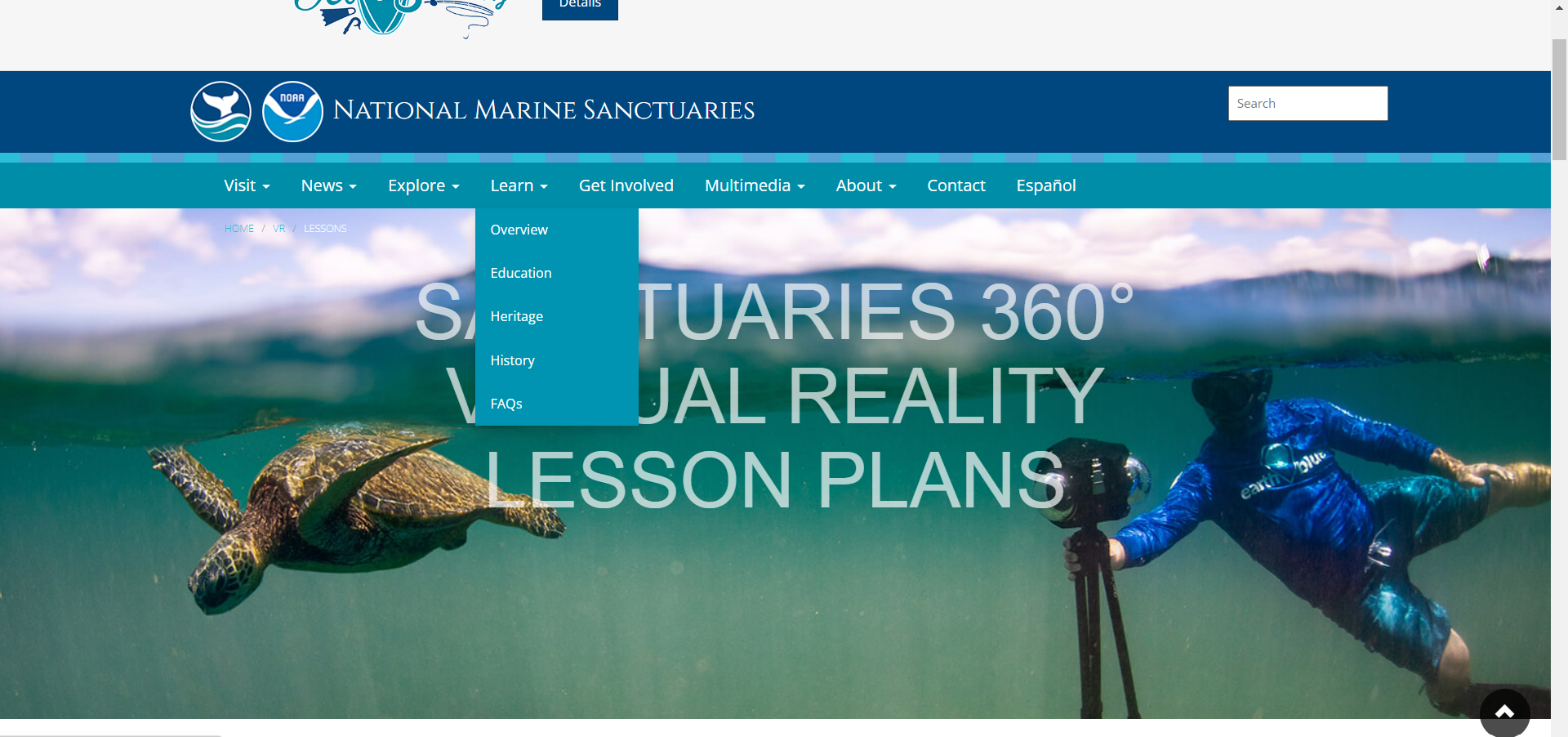

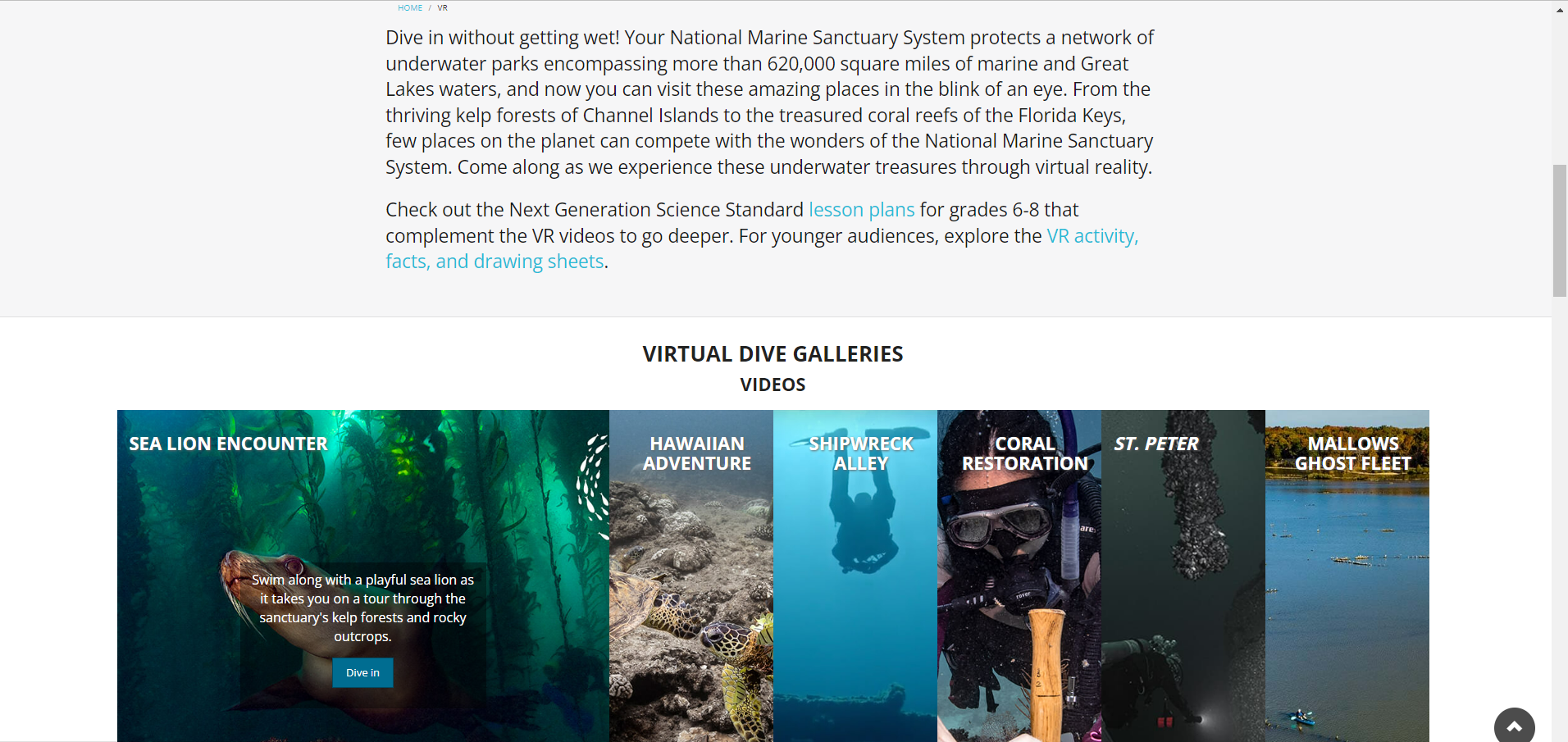
Each of the six 360 video that are offered is around three to four minutes long. There are also 360 pictures that the website offers; these pictures are of different bays and coast and other areas of the ocean. They are not partnered with the lesson plans, but the images are beautiful, give small sentences to inform the viewer about what they are seeing, and worth checking out in my opinion. After watching the video and learning about different areas of the ocean or the animals that inhabit it, the lesson plan can be used. The lesson plan below is paired with a 360 video about sea lions. The lesson features discussions about the environment the animals live in, different plants in the area, and the different adaptations the animals needed to survive in the cold waters.
After learned about the sea lions and how they live in cold water student will participate in an experiment that demonstrates how insulation works. Using two jars on hot water, one will be insulated with materials that students brainstorm about using. After they come up with ideas and run their experiment, they given time to discuss their finding with their group and the class.
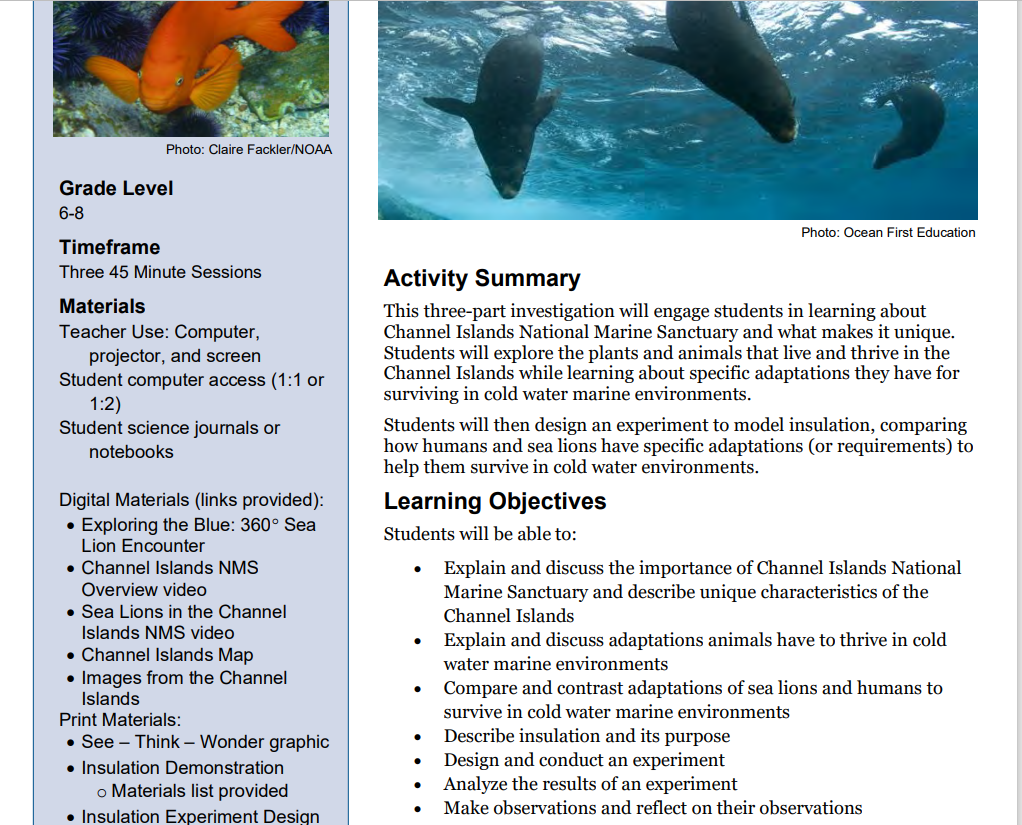
The 360° videos offered on YouTube are amazing and I really loved my experience with them. I think they can add a lot to any educational experience by allowing learners to get closer to the topics at hand. The National Geographic YouTube channel has a lot of these 360° videos and the topics are varied. The National Marine Sanctuaries website took the 360 videos a step further by adding their own lesson plans and activities to give students and teachers and deeper understand of what they just watched. In an article from Structural Learning.com, they explain that VR in education offers students immersive environments to practices their skills in scenarios that are controlled. The use of VR also enhances the learning experience by increasing engagement and retention of information; this happens because the student is experiencing what they are learning about instead of hearing about it. The medium of VR and 360 videos also allow learners to be put into all types of situations, allowing for deeper emotional connections with the source material and developing empathy by taking someone else’s perspective. A perfect example of this is when I was watching the 360° Sea Plastic video. Beaches near me are pretty clean but, I was put into an area where they water ways were filled with trash and I was upset by what the plastic trash was doing to the environment. I’m personally looking forward to the watching 360 videos get better and better and seeing how they can be implemented to enhance education.
Ways to Support Students Who May Come from Trauma
When teaching students, educators have to be aware that students come from different backgrounds and may have many stressful events going on in their lives, therefore, it is important to support these students as best as you can so they are able to receive an education. The article “5 Things Every Teacher Needs To Know to Create a Trauma-Informed Classroom,” goes into detail about how to best suit students that may be experiencing some form of neglect, abuse, and/or violence. Classrooms should be a safe space for students, they should feel welcomed, and feel like they can trust the teacher.
The first thing to do in order to support students is to understand where they may be coming from. Many students that act out may come from troubled homes and it is important to keep an open mind to that idea so you can best support them and provide them with the best education. When students experience some sort of trauma their nervous system is filled with stress hormones, and because of this learning can be hard for those students. In order for students to learn and perform their best they need to feel a sense of trust so they are not filled with stress while at school.
Providing support for students can look many different ways. One example explained in the article was a teacher in Alabama who would make their classroom cozy and welcoming for students by having blankets, stuffed animals, and a fridge with different snacks for the students.

Another teacher, from Missouri, explains how she lets her students decorate their classroom. In doing so it makes sure the students are comfortable in the environment they are in and creates a sense of trust knowing their teacher has given them the privilege and opportunity to create the classroom how they want it. It also allows the students to have a sense of control and a sense of themselves. The students have the ability to be themselves in the classroom, which is not always allowed in their home life.
For my classroom, in the future, I will use these different tools to create an environment where my students will feel welcomed, safe, and feel like they can trust me. I specifically love the idea of having a fridge with snacks since students cannot focus on learning if they are going hungry. When I was in high school I had a teacher who had snacks and a coffee maker in her room for students to use, this teacher was also one that all students trusted and felt safe to talk to, this shows how even the little things can make a large impact on the students. My classroom will also be lively with lots of colors and diversity to create a more welcoming appearance, as well as comfortable areas for students to be able to relax. Although these may seem like little things to add to my classroom I believe it will create a trusting and supportive environment. With trust, I can learn more about my students and what their needs may be to continue to provide for them and to create their learning experience the best it can be.
Virtual Field Trip: Wild Cats in Vladivostok, Russia
Using the Website AirPano I was able to go on a virtual safari in Vladivostok, Russia at the Primosky Safari Park. The park houses multiple wild cats including lions, tigers, leopards, cougars, and lynxes. The virtual safari included videos of the animals and provided educational information about each of the wild cats. The park has many different cameras in the exhibit so the video allowed the viewer to see the wild cats from many different perspectives. As well as showing the animals, the video shows the setup of the park where visitors can see inside the exhibits. The visitors can stand on bridges high above the exhibit so the wild cats cannot get out but the visitors also can see an overview of all the cats. The video explains how the park’s goal is to rehabilitate animals that can no longer survive in the wild, although their exhibits are similar to their natural environments with many trees and large areas of land.
The video is educational and explains facts about each of the different wild cats. The viewer also learns the background of each of the wild cat’s in the park, like their specific species name and how long they have been in the exhibit. We first learn about Tigers. Tigers are not dangerous to humans unless provoked, they also bond with different species of animals. The video explains how one Tiger has bonded with a Goat, which most people would think is quite unusual. Next, we learn about African Lions. They are an endangered species. When Amur Tigers and African Lions mate they create a hybrid. These hybrids are not found in the wild but are only found under human supervision.

After the African lions, we learn about the Leopards. Breeding of these Leopards and other cats takes place as part of the environmental protection program. Although as of now, the park only has two Leopards that are separated in different enclosures. We then learn about the Canadian Cougar. They are an independent living species and a solid predator. They hunt at night although are very curious animals. Lastly, we learn about Lynxes. They are smaller than the other wild cat species, weighing at most 30 kilograms, which is equivalent to about 66 pounds. In the park, the Lynxes like to play with each other.
After going on a virtual field trip, through AirPano. It is shown this is something that can be used in the classroom to provide students an education in different locations all around the world. On this particular field trip, the viewer is being educated on the topic of wild cats, while also being able to experience how they would act in the wild and hearing how they sound. AirPano is not just videos but 360-degree tours of different locations. These locations range from cities around the world to the great pyramids to different islands. Therefore, whatever topic an educator is teaching there is a wide range of videos and 360-degree tours to create an educational virtual field trip for students.
WE Learning Resources: Visual Arts and Community Outreach
Have you been looking for ways you and your school community can make a larger impact on our world? Are you looking for ways to promote global sustainability and inclusivity while also staying true to your content area? Well, look no further than WE.org. WE is an organization that helps classrooms around the world expand their volunteering efforts beyond their school communities. They provide resources such as videos, conferences, lesson plans, events, grants, and so much more in order to help you and your students achieve your goals.
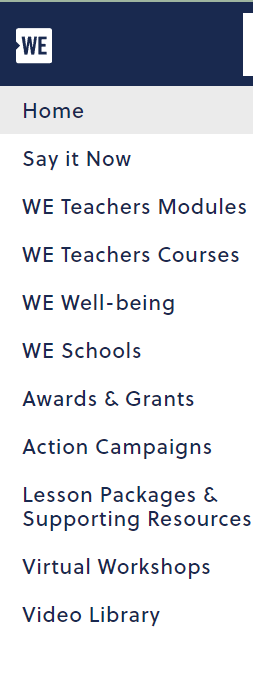
Using their Virtual Learning Center, educators can find lessons and professional development courses that will help them provide the education they need to students about ways they can get involved and why they should. They focus on several global sustainable development goals including things such as hunger, waste clean up, and equity. There are lists of several campaigns for classrooms to get involved in. Or you can view their lesson plans and modules to learn about a specific goal or volunteer effort and you and your students can develop your own campaigns. Through this site you can also get grants to support your campaign and expand your outreach. All of their resources range from kindergarten to the high school level, so it really is for everyone!
As a future art teacher, I wanted to find lessons or campaigns I could use in my classroom where students can use the visual arts to help promote or be a part of any cause they had to offer. I was able to find a couple of lessons that I could see myself using in the future as ways to get my students involved.

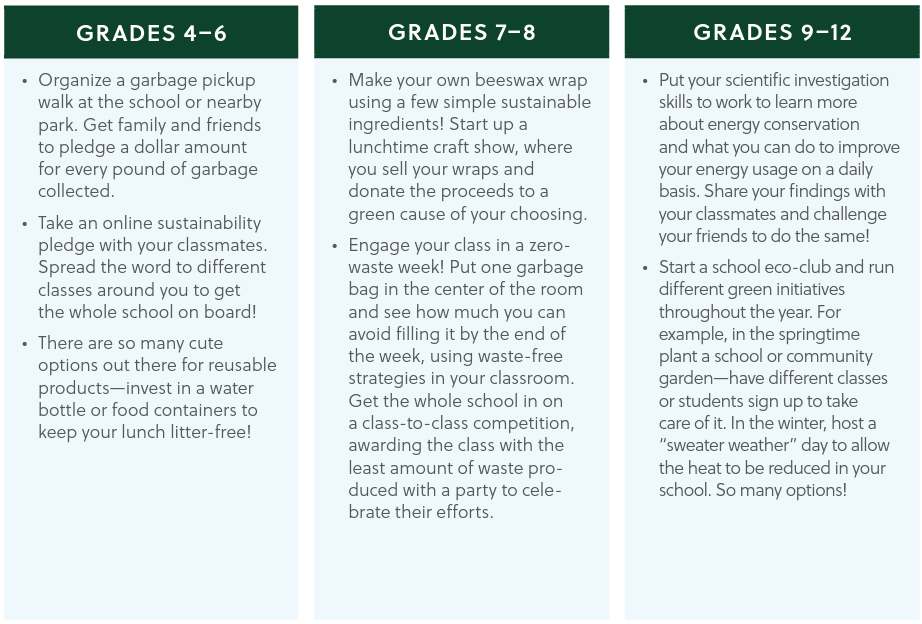
We Go Green is a campaign outline that guides teachers through teaching students about waste and recycling. At each grade level, students will learn statistics about waste and recycling and come up with plans on how they can promote having a green thumb or how they themselves can help contribute to reducing waste.
Students individually or in groups can make their own goals and come up with a plan to achieve them. Then they can give themselves jobs within their campaign for how they will help to complete their goals. I thought this was interesting for an art classroom because not only can they create beautiful posters and works of art that promote recycling and reducing waste, but they can also use the waste!

By collecting trash and recycling from around the school, home, and in their communities, they can repurpose this trash to make works of art that are representative of the cause. I could even see myself planning an art show within the school to showcase the work. The event would showcase student work and display how many pounds of waste they were able to upcycle to create their work. And on a larger scale, we could possibly even turn it into a fundraiser!


Understanding Local Hunger is a unit plan on WE.org that teaches students about hunger and low resources on a local to global scale. Throughout the unit, the teacher will guide the students on learning about hunger, analyzing the statistics, coming up with possible causes, and then creating and developing possible solutions. These lessons come in all grade levels. However for the purpose of talking about how I would use this resource, I am focusing on the high school unit. These lessons are fully developed including the common core standards, objectives, resources, and procedures for each lesson. The structure for each lesson unique and caters towards all types of learners and works across all content areas. These lessons pull from math, science, English, history, and the visual arts in order to create a dynamic unit that fully encompasses everything students would need to know before developing their solutions.
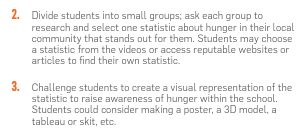
Lesson 5 is specifically what I want to focus on since it involves media. In this lesson, students would have to use any art form, digital or traditional, to create a visual representation of a statistic about hunger.
I think this is an amazing lesson and project that I could have them do in groups for two to three days or individually over the course of a few days. In addition to teaching them about hunger and why it is so important, this would also be a great time to teach them about how visual media can display messages and create an atmosphere or certain perception of their subject. We could also tie in a lesson about symbolism and how certain symbols or aesthetic choices can change the meaning of your work. We could view examples of works by famous photographers, painters, and graphic designers that depict hunger and its impact on society. Students can gain inspiration about how to convey their message and statistic and use what they have learned to create their visual representation. Again we can even share these on a larger scale in an art show or online gallery!

As mentioned, if I were to pursue these projects, I would want my students to be able to share their work on a larger scale and make the greatest impact. I would want my students to understand how art can impact people and promote and messages that are important in ways that sometimes words cannot only describe. Therefore, I could reach out to WE.org and apply for their action grants such as the Heartwarming Project. Through this grant we could receive some funding that could help is in sharing their hard work outside of our school community by creating a larger event where we can to donation drives, fundraisers, recycling program, and so on. WE.org is truly a great organization and is something I will heavily consider looking into more in the future when I have my own classroom.
CHECK OUT WE.ORG FOR MORE INFORMATION ON HOW YOU AND YOUR STUDENTS CAN GET INVOLVED!
Thank you for reading!
Follow me on Twitter at @IreneOrtiz001
Mental Health in Classrooms
Mental health is critical to students’ general prosperity and scholarly achievement. Students’ mental health can be supported or challenged by the environment in their classroom. It is imperative for educators to pay close attention to the mental health of their students and to foster a supportive environment that encourages emotional well-being. Teachers can positively impact students’ lives and help them succeed academically and personally by addressing mental health in the classroom.
We.schools.org has brought light to the attention of mental health for students and the importance of it. (On the right.)

Establishing a protected and comprehensive homeroom environment is urgent for supporting students’ emotional and mental health. Students can develop an environment where they feel at ease expressing their feelings, sharing their experiences, and seeking assistance when needed. Undivided attention and compassion are fundamental abilities for educators, permitting them to recognize indications of pain or psychological well-being worries in their understudies. Teachers can foster open communication and make students feel valued and understood by being approachable and non-judgmental.
We.schools offers a variety of modules for anyone to look into.

They say,
“Engage students in issues related to the theme of Health and Well-being. Here you will find topics like mental health and well-being, bullying and cyberbullying, nutrition, physical health and healthy relationships.”
Through scrolling, you are able to scroll and examine different modules that relate to Healthy relationships, Mental Health & Wellbeing, and Nutrition (as well as bullying, clean water, and physical health.)

Executing mental health schooling inside the educational plan is indispensable to supporting understudies’ prosperity. Teachers can teach students valuable skills for effectively navigating their emotions by incorporating emotional intelligence, stress management, resilience, and self-care lessons. Teachers can help their students prioritize their mental health by teaching mindfulness techniques, promoting healthy coping strategies, and providing resources for mental health support.

The advantages extend beyond the classroom when teachers actively support students’ mental health. Students are more likely to develop a positive attitude toward learning, exhibit improved academic performance, and have better overall life outcomes when they feel emotionally supported and understood. Teachers can assist in preventing potential difficulties from growing and provide students in need with the necessary support and resources by addressing mental health issues early on.
The classroom-based modules that weschools offer fosters collaboration, empathy, and genuine care for and with others by bringing together a profound sense of oneness. The purpose of these transformative modules is to instill a profound appreciation for the interconnectedness of the classroom community.
Students are encouraged to recognize that they are part of a larger whole and that their thoughts, actions, and well-being are intricately linked to the well-being of their peers by embracing the concept of oneness. By eliminating divisions and encouraging inclusion, this understanding fosters a sense of unity and belonging. Understudies figure out how to commend the variety and worth of every individual’s one-of-a-kind points of view and encounters in the aggregate learning space.
Inside this supporting climate, cooperation becomes the dominant focal point. Understudies are urged to cooperate, consolidating their assets and gifts to accomplish shared objectives. They know that a team’s progress is more important than a person’s success. Through collaborative projects and activities, students can learn essential skills like effective communication, active listening, problem-solving, and compromise.
Greater empathy is naturally developed in students who participate in collaborative learning experiences. They figure out how to genuinely see and grasp their companions, perceiving the everyday human encounters that tight spot them. Through dynamic sympathy, understudies foster the ability to focus on others. They listen mindfully, approve feelings, offer help, and try to grasp alternate points of view. Within the classroom community, acts of kindness, compassion, and support become second nature.
Educators are essential in encouraging unity, coordinated effort, and care. They make a safe and sustaining space where understudies feel open to putting themselves out there and embracing weakness. Teachers encourage students to emulate these characteristics by modeling them for them. They facilitate opportunities for students to connect on a deeper level, encourage active participation, and encourage open dialogue. Instructors and mentors encourage understudies to become humane and drawn-in homeroom local area individuals through their direction and mentorship.
The advantages of developing unity, cooperation, and care in the study hall stretch far past scholarly accomplishment. The fundamental life skills that students acquire will benefit them personally and professionally. They learn to esteem cooperation, regard different viewpoints, and explore clashes with elegance and understanding. The feeling of having a place and connectedness they experience cultivates good emotional wellness, versatility, and a more noteworthy identity worth.
Focusing on oneness, collaboration, and care in the classroom is truly transformative in a world that frequently emphasizes competition and individualism. It supports an age of people who grasp the force of solidarity, esteem the strength of aggregate exertion, and focus on the prosperity of others. These modules make an enduring effect, molding understudies into caring, sympathetic, and socially mindful people prepared to decidedly impact their networks and add to an agreeable and interconnected world.
WE Teachers and the Bullying Module
Growing up my school had a pretty good no bullying policy. It still happened, but for the most part it was a good environment to learn in. I would like to continue this anti bullying policy and the We Teachers Bullying Module is a good tool for doing exactly that. The module first goes over terms and statistics about bullying so that everyone can have the same understanding of what is being talked about. There are many types of bullying, like verbal, social, and physical, and then there are types of bullying that are more specific like cyberbullying, sexual harassment, and discriminatory bullying. Bullying is a major problem because it has negatively impacted everyone involved which is why it is important to stop it as soon as possible.
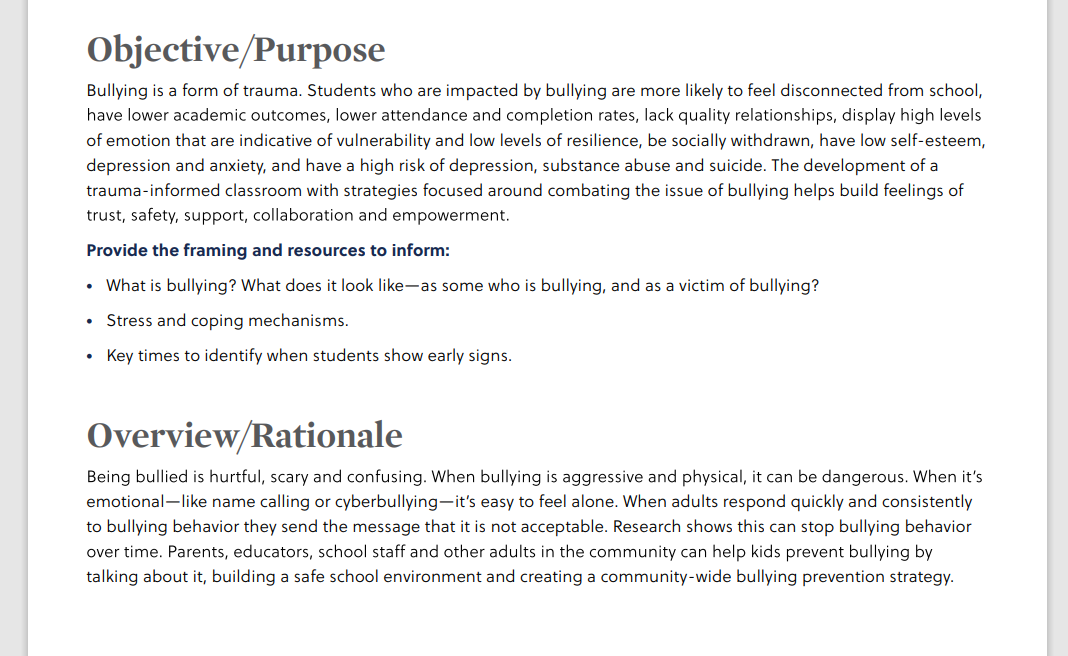
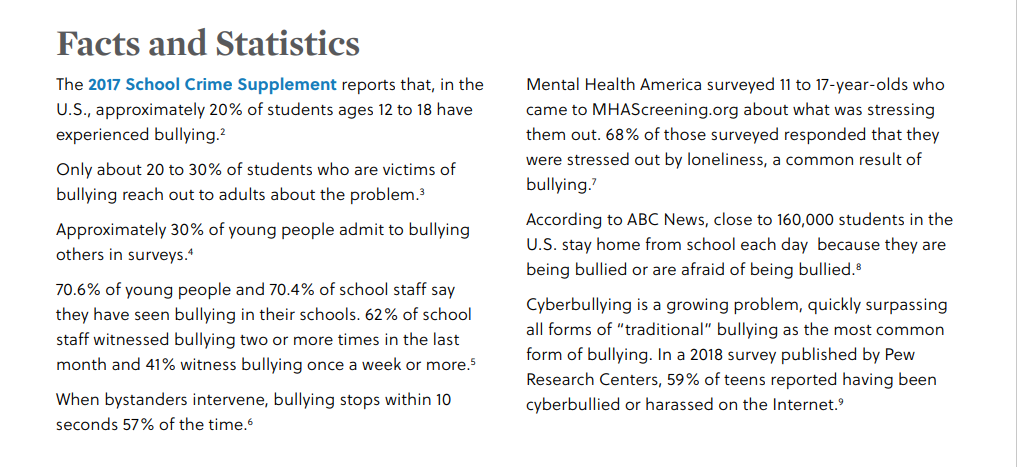
The module gives advice on preventing bullying like identifying bullying hot spots as a way to stop it from taking place. It could be a certain bathroom, hallway, or somewhere outside on school grounds. Monitoring these spaces makes sure that the perpetrator and the victim of bullying know they are being seen if something were to happen.
Some of the ways they suggest taking action is by updating the policies and procedures are bullying and talking to the parents. They also giving some insights on Zero Tolerance Policies and how some actions that can be taken to prevent bullying could make it worse. Something I thought was important that the module stressed was not labeling the bully. Giving labels to someone can cause them to act a certain way, instead it tells educators and facility members to tell students that are participating in bullying that “we don’t treat people that way” or that “this behavior is not acceptable.” This specific way of phrasing your message to the student makes it so their behavior is being addressed as the problem and not themselves.
For teachers, the module goes over ways to stop bullying before it starts. You can do this by establishing a culture of inclusion, setting a ton of respect, developing rules with the students, being a good role model, rewarding and acknowledging good behavior, and having meetings with the class. The module also gives advice to teachers on what to do when a student comes to you with an issue about bullying or if you witness bullying.
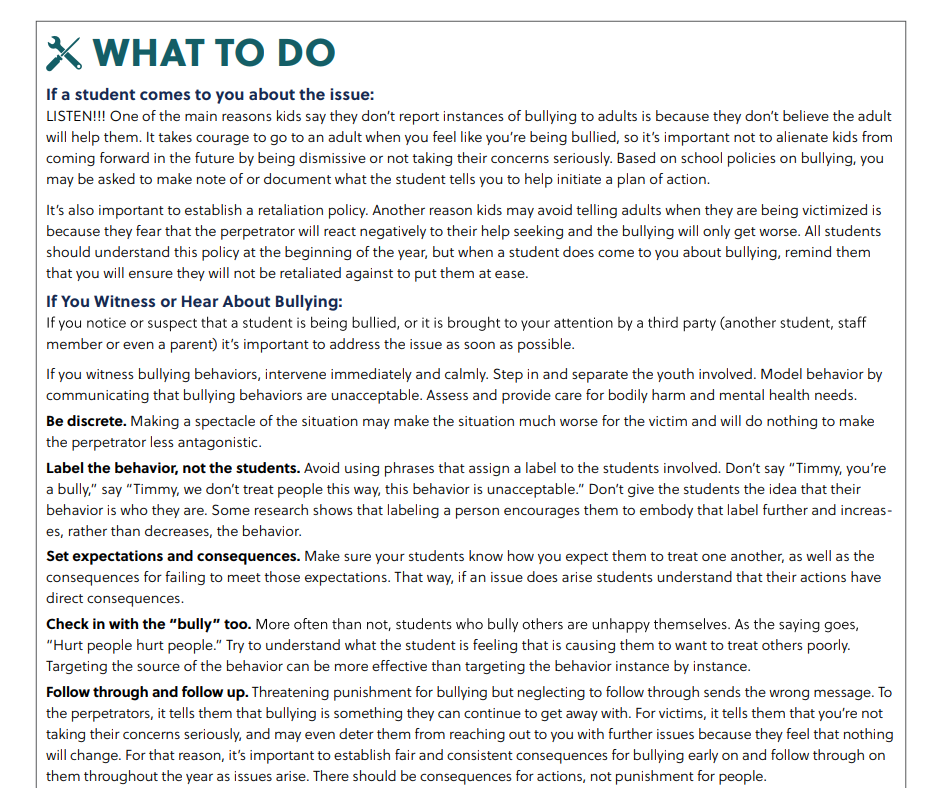
This module also comes with worksheets and activities so you can go over what you’ve taught your class about bullying. It also offers worksheets on different scenarios that might occur and had a perspective taking worksheet for educators. I think some of the best resources the module offers are discussions for understanding bullying, with questions to get conversations started, and a section on how to introduce the topic to teenagers and getting them to care about the issue.

I think that the WE Teacher Modules are incredible resources that can offer a lot of help. I’ve always wanted to be a teacher that could help prevent bullying, but I wasn’t sure how I was going to actually accomplish that goal. There were the obvious steps to take like talking to the class and telling them what is expected from them, and also stopping anything I saw by intervening, but other than that I was kind of lost. This module will really help me implement strategies in the classroom so that the learning environment is safe for everyone.
WE Teachers
This website was really neat. I just learned about this organization. Having never heard of it, I was fascinated. Let me briefly tell you in case you know nothing about it as well. Number one, it’s all free! Right?! I know most things that are really worthwhile aren’t free. Well, this is. This website has a place for teachers to view and learn over 10 modules, on topics like mental well-being, bullying, poverty, social and emotional learning, and youth violence.
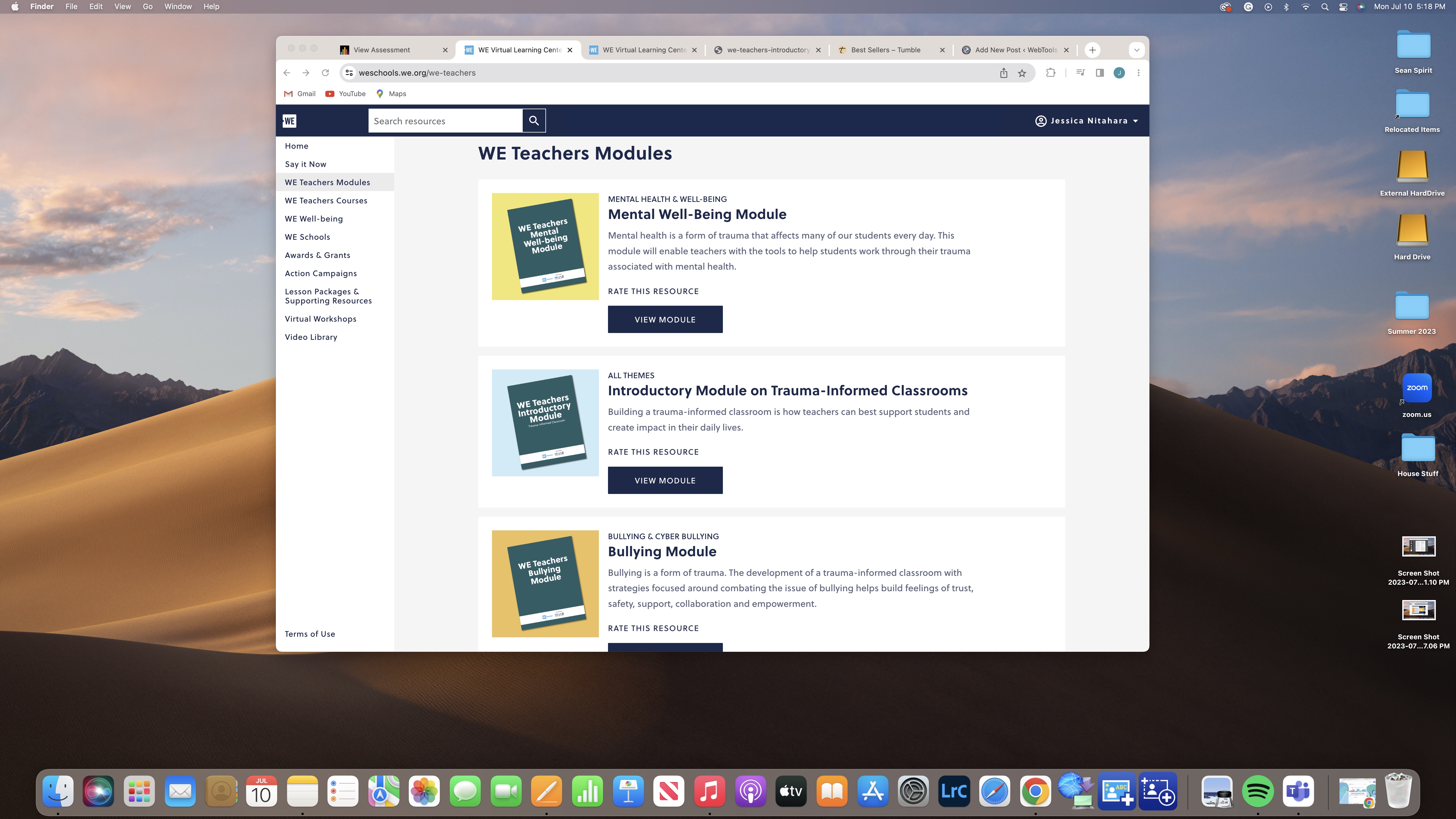
I went ahead and read/completed a module that interested me, Trauma-Informed Classroom. Post-pandemic this is necessary more than ever. What stuck out to me was in this module they told you about a trauma-informed classroom, what to look for, and what to expect from students who have experienced trauma but what’s even better was they had a self-assessment for teachers and a worksheet at the end.
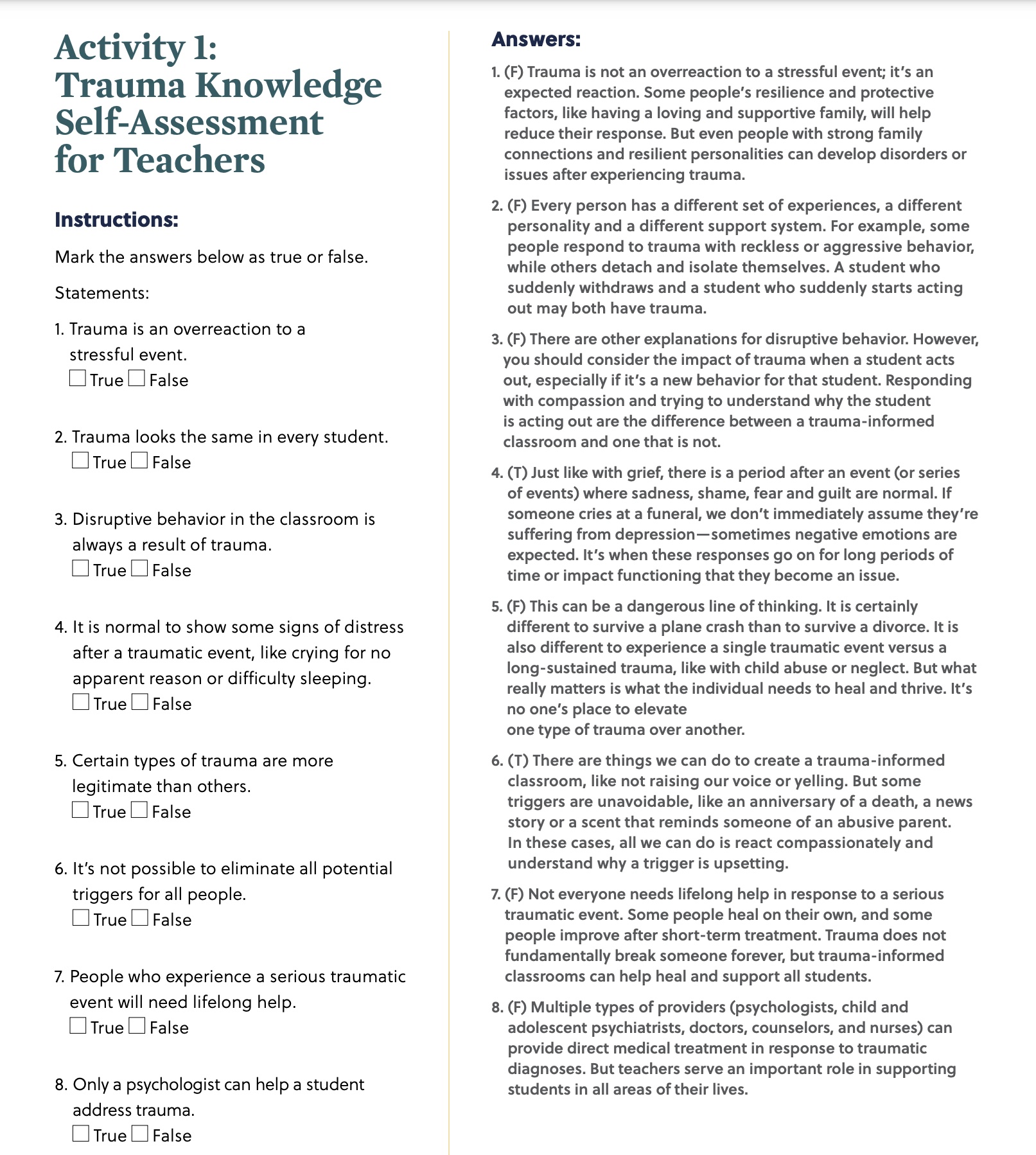
Another aspect of this module was that they included other types of trauma that maybe you wouldn’t think of when thinking of trauma. Accidents or disasters could be trauma. When I was in 9th grade my house and all our belongings and our family dog were gone. It was so hard for us. We were offered counseling and the school and community came together to help us get some material things back but I was never the same. I always struggled since then and I think that’s why I’m so drawn to trauma-informed training. I know there are all types of trauma and I want to be able to help anyone that I encounter in my class or outside the best I can.
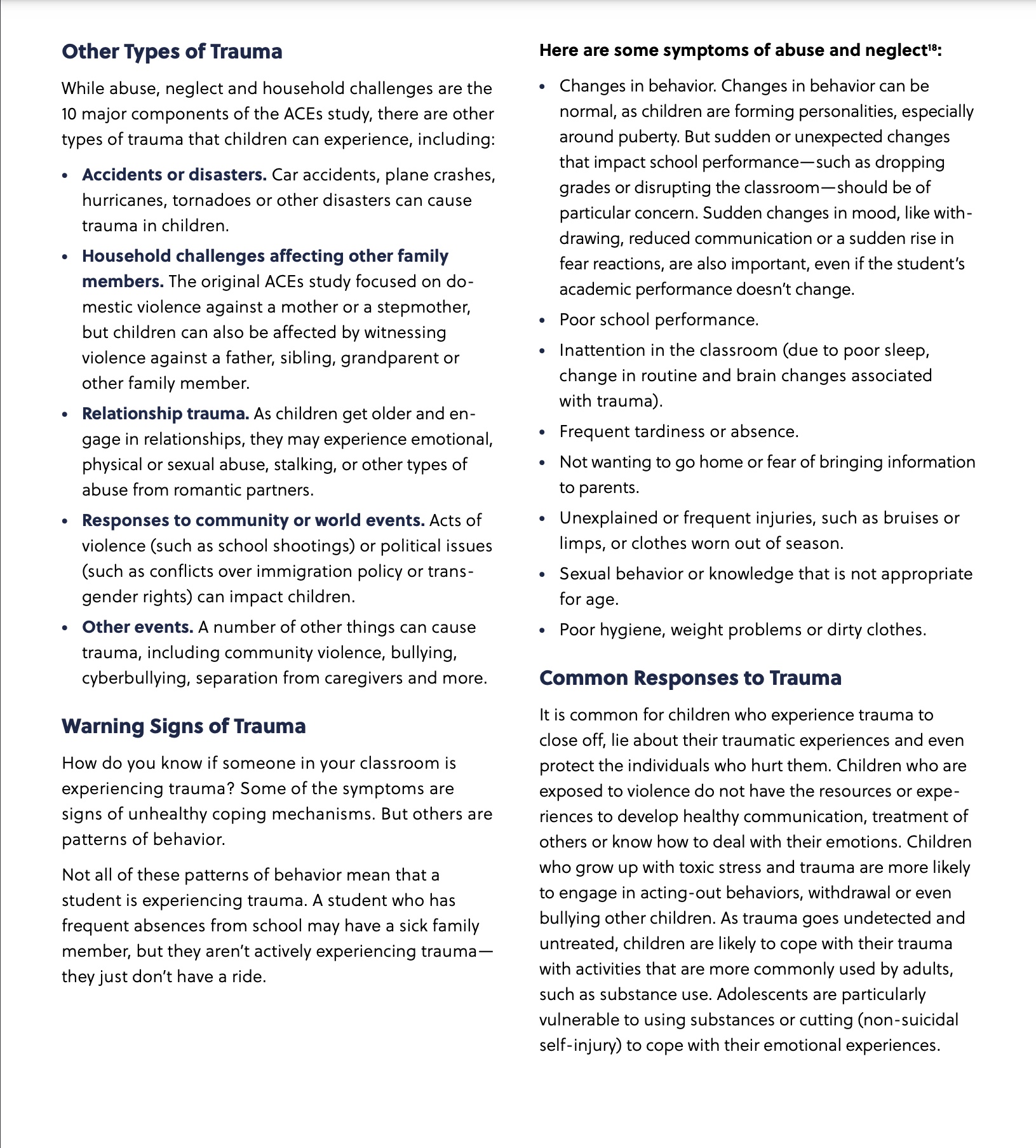
After modules, you can actually see there are courses available. I didn’t finish a course, but I listened most of the way through Mental Well-Being In the Classroom. What I loved is they touched on what mental well-being is, the risk factors, and then talked about suicide and the warning signs. That’s as far as I got into the video but I think it was really beneficial. The one thing that stuck out to me was the difference between risk factors and protective factors. I think knowing these about your students will allow you to know how to best help and serve your students. Again there are over 10 courses free for you to take, which is amazing.
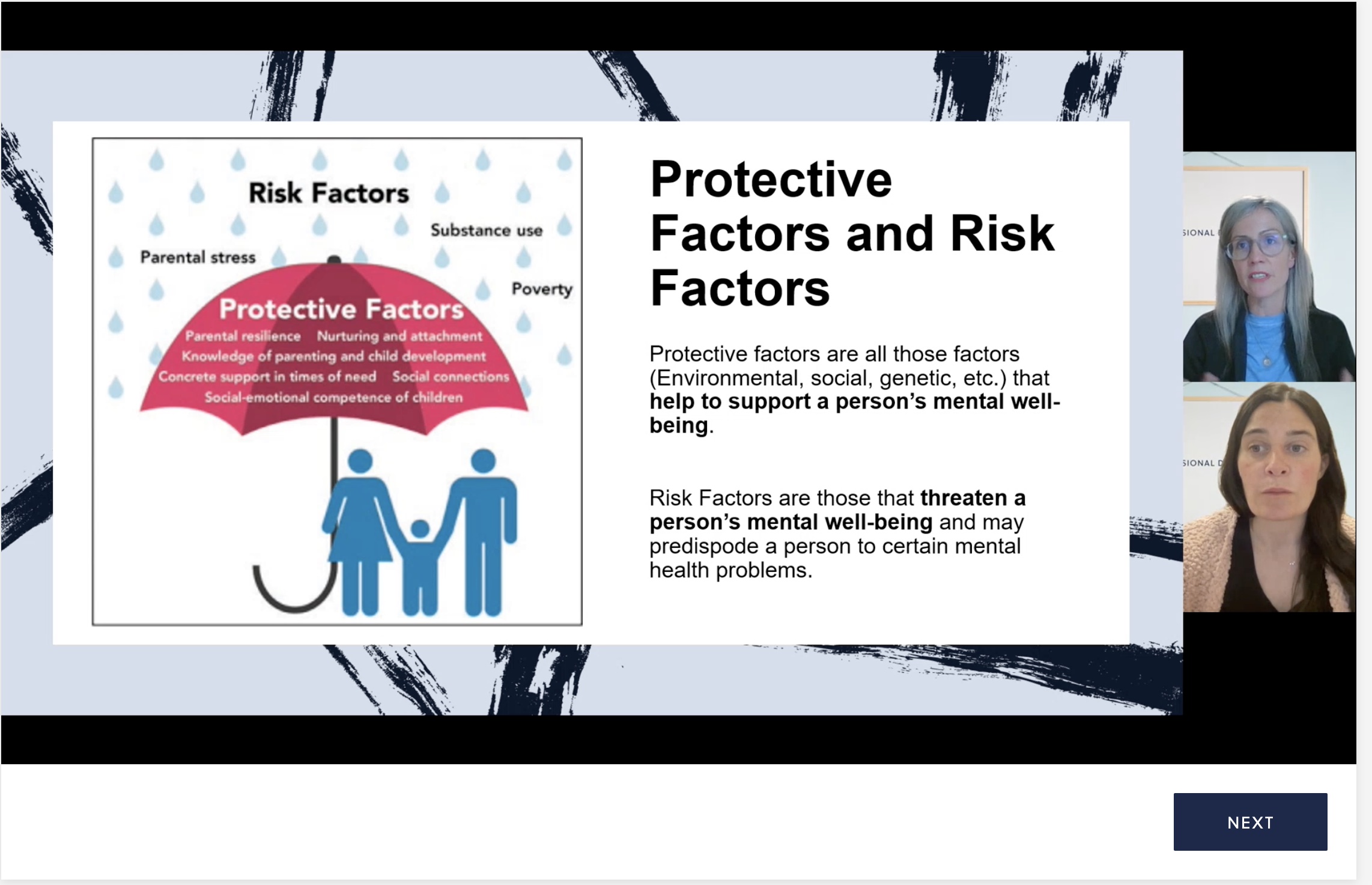
Those are just two main things I checked out in-depth, but there are also additional resources on well-being, resources for schools, videos, and virtual workshops. I hope you’ll check it out and find something that interests you.


